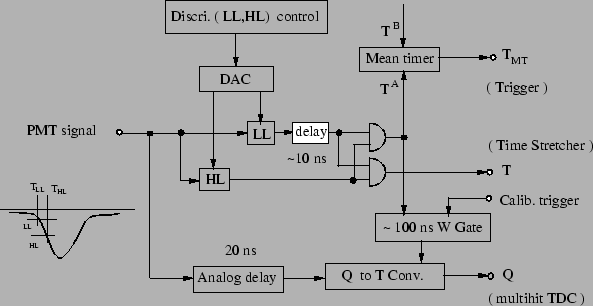Table:
Parameters for TOF/TSC electronics.
| Input signal |
BC408 (Scint.) |
 4 ns (PMT 4 ns (PMT  2.5 ns) 2.5 ns) |
| |
R6680 (PMT) |
FWHM  10 ns 10 ns |
| |
|
V 5 V (1.2 5 V (1.2  1.5 V/mip) 1.5 V/mip) |
| |
|
Signal rate  17 kHz at 17 kHz at  0.2 mip 0.2 mip |
| Q-to-T |
MQT300 |
Self gate (width  100 ns) 100 ns) |
| |
|
Dynamic range: 0  500 pC (11 bits) 500 pC (11 bits) |
| |
|
Nonlinearity  0.1 % 0.1 % |
| |
|
Dead time = 5  s max. s max. |
| Discriminator |
MDC100A |
Level : 0  2 V 2 V |
| |
(MVL407S) |
HL for self gate/trigger |
| |
|
LL for timing |
| Mean timer |
Delay line |
Input signal width = 30 ns |
| |
|
Delay = 32 ns |
| |
|
Time jitter  5 ns 5 ns |
| Time stretcher |
|
Clock period = 16 ns (8 RF) |
| |
|
Expansion factor = 20 |
| |
|
Time jitter  20 ps 20 ps |
| |
|
Dead time  1 1  s s |
| Reference time |
RF clock |
Total uncertainty  30 ps 30 ps |
